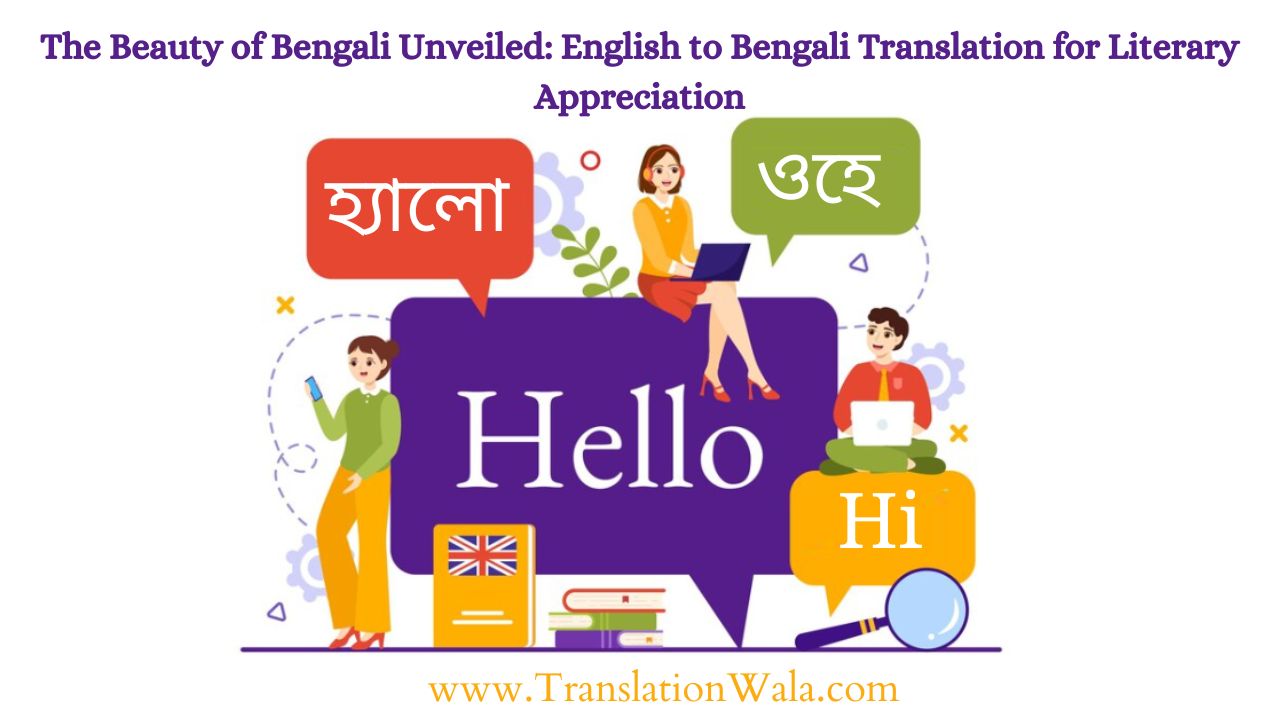Bengali writing has been thriving for hundreds of years, telling stories of love, loss, and freedom that have touched millions of people. But people who don’t speak Bengali have often had trouble getting to this treasure trove because of language barriers. English to Bengali Translation is an art that lets you see the literary beauty of Bengal and gives you a deep understanding of how it is expressed.
The Dance of Words: Capturing the Nuances of Bengali
It’s not just moving words from one tongue to another when you translate Bengali writing. It’s a careful dance of understanding and perception, an attempt to catch the spirit of a society that’s built into the language itself. Bengali is hard to learn because of its beautiful sounds, complicated language, and many cultural references. Translators have to find their way through the confusing maze of meaning, where a single word can mean a lot of different things.
One example is the word “bhoy,” which usually means fear but can also mean awe, fear, and a sense of the supernatural. Simply translating it as “fear” would not do justice to the wide range of feelings that are contained within it. A good translation will look for an English word that means the same complex mix of emotions. For example, they might choose “awe-struck fear” or “fear tinged with reverence.”
The task goes beyond just a few words. Bengali phrases, proverbs, and cultural references are often hard to translate word-for-word. Imagine translating “Kobir Bhoy,” a poem by Jibanananda Das in which the author talks about being scared of “Kobir,” which is his or her own voice. A direct version wouldn’t show the complicated fear of expressing oneself and the fear of entering the world of creation. A good translation might say “fearing the muse,” which is a phrase that makes you feel both creative and vulnerable.
Also Read: The Role of Technology in English to Gujarati Translation: Streamlining the Process
Beyond Fidelity: Reimagining Bengali for a New Audience
A good translation is more than just correct. It tries to rethink the Bengali text for people who don’t read Bengali so that they can understand the cultural details and emotional depths that are woven into the story. This usually means taking artistic license, like using metaphors or phrases that are important to the target audience’s culture.
Take a look at “Gitanjali,” a collection of religious songs by Rabindranath Tagore. If you don’t know what Bengali nights are like, his symbols like “fireflies dancing in the jasmine grove” might not make the same impression on an English reader. Perhaps the translation would pick “fireflies sparkling amidst honeysuckle vines,” which would give the viewers a clearer picture.
Finding the right mix between staying true to the original and being easy for new audiences to understand is key to the success of these kinds of reimaginings. The translation acts as a culture representative, connecting two different worlds and making sure that the main idea of the Bengali text comes through without losing its own flavor.
A Window to New Shores: The Impact of Translation
English to Bengali Translation is an important part of making both languages’ writing scenes better. It helps Bengali people read more by presenting them to great works of writing from around the world. On the other hand, it lets people from all over the world read Bengali writing, which promotes understanding and respect between cultures.
Works translated into English, such as “Meghnad Badh Kavya” by Michael Madhusudan Dutt and “The Land of Two Rivers” by Manju Sarkar, have gained new fans and praise from critics. These versions not only show off the skill of Bengali writers, but they also give readers a look into the political, social, and cultural life of Bengal, which helps people from different countries talk to each other and connect.
Also Read: Navigating Cultural Nuances: English to Marathi Translation Insights
Moving Forward: The Road Ahead for Bengali Translation
Translation into Bengali is getting harder as it grows. Expert translators who know a lot about both languages and places are still very much in demand. There are tools that can help with translation thanks to progress in technology, but the creative interpretation and cultural understanding of a human interpreter are still the most important parts of the process.
Bengali works that have been translated can also reach more people by being promoted at literary events, book clubs, and online. It is very important to keep the flow of creative exchange going by supporting new authors and giving them ways to get their work published.
Conclusion: A Celebration of Language and Culture
Besides being a job, English to Bengali Translation is also a celebration of language, society, and life in general. Because they put together this difficult dance of words and meanings, translators bring out the beauty of Bengali writing. You can see the heart and soul of an active society through them as well. People will learn more about how rich Bengali writing is as we work to close the language gap. The books they read will be more varied, and they will learn more about how people live.
